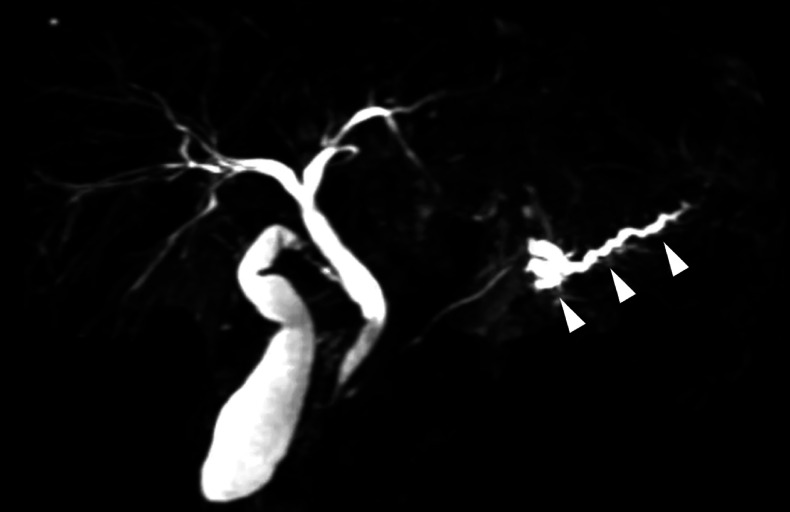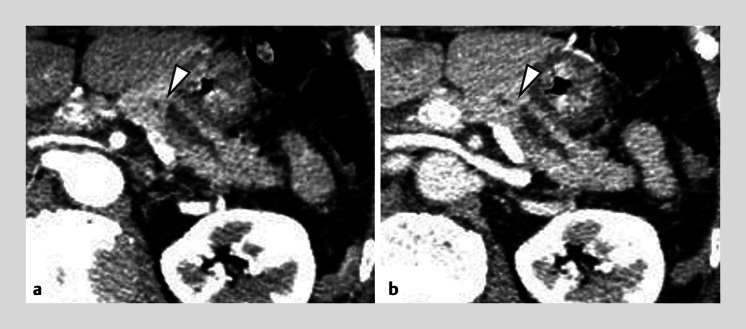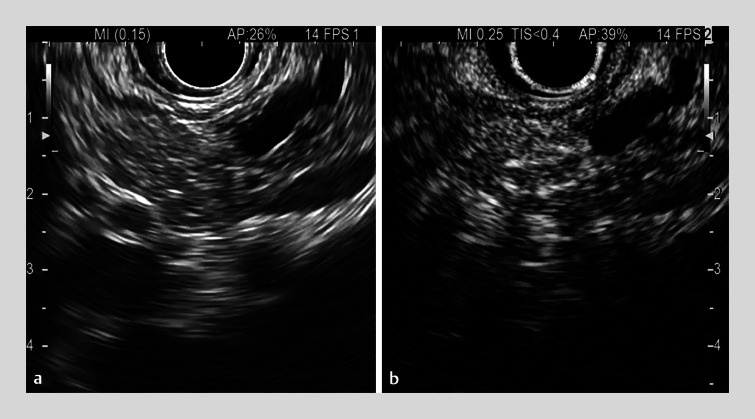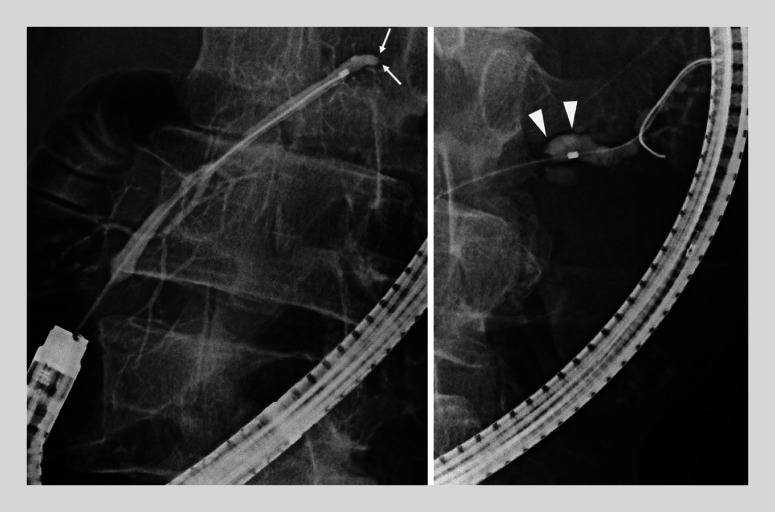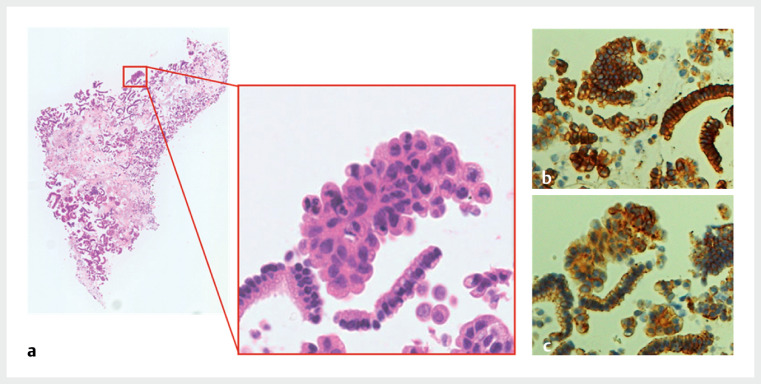Pancreatic juice cytology (PJC) performed via endoscopic retrograde cholangiopancreatography (ERCP) has been adapted as an alternative to endoscopic ultrasonography-guided tissue acquisition for identifying pancreatic ductal adenocarcinoma (PDAC) in cases in which mass lesions cannot be visualized; however, its diagnostic accuracy is limited 1 2 . Recently, PJC using a cell-block (CB) technique (in which tissue fragments obtained from pancreatic juice are processed into paraffin blocks) has been reported 3 4 5 . Herein, we report a case of early-stage PDAC diagnosed using the CB technique in a patient with altered anatomy. An asymptomatic 63-year-old man with a history of Billroth-II gastroenterostomy presented with main pancreatic duct (MPD) dilatation. Magnetic resonance cholangiopancreatography revealed MPD dilatation in the body and tail of the organ ( Fig. 1 ). Contrast-enhanced computed tomography revealed focal MPD stenosis in the body of the pancreas with no obvious mass lesions ( Fig. 2 ). On endoscopic ultrasonography, although localized MPD stenosis in the body was detected, mass lesions were not visualized even with contrast-enhanced imaging ( Fig. 3 ). Then, single-balloon enteroscopy-assisted ERCP was performed. On pancreatography, the MPD was narrowed in the body, and the dilated caudal MPD could be imaged only after guidewire passage ( Fig. 4 ). A 5-mL aliquot of pancreatic juice was aspirated using an ERCP catheter with negative pressure via a 10-mL syringe. Half of the collected pancreatic juice was used for PJC and the rest for CB. Although PJC was indeterminate, histopathological evaluation of the CB specimen revealed atypical cell clusters with irregular-size nuclei that tested positive for Ber-EP4 and Claudin-4 on immunostaining ( Fig. 5 , Video 1 ). Following distal pancreatectomy, a final diagnosis of stage IA PDAC with a tumor diameter of 6 mm was made. This case highlights the usefulness of the CB technique with ancillary immunostaining as a diagnostic tool for PDAC, even in patients with altered anatomy.
Fig. 1.
Magnetic resonance cholangiopancreatography showing main pancreatic duct dilatation in the pancreatic body and tail (arrowheads).
Fig. 2.
Contrast-enhanced computed tomography showing focal main pancreatic duct stenosis in the pancreatic body with no obvious mass lesions (arrowheads). a Early phase. b Delayed phase.
Fig. 3.
Endoscopic ultrasonography showing no visible mass lesions in the pancreas around the focal main pancreatic duct stenosis. a Fundamental B-mode image. b Contrast-enhanced harmonic image.
Fig. 4.
Pancreatography using single-balloon enteroscopy-assisted endoscopic retrograde cholangiopancreatography showing main pancreatic duct stricture in the body of the organ (arrows). The caudal pancreatic duct could be imaged only after the guidewire advanced beyond the stricture (arrowheads).
Fig. 5.
Histopathological evaluation of the specimen via the cell-block technique demonstrating a atypical cell clusters with irregularly sized nuclei b that tested positive for Ber-EP4 and c Claudin-4 by immunostaining.
Early diagnosis of pancreatic cancer via pancreatic juice cytology with a cell-block technique in a patient with altered anatomy.
Video 1
Footnotes
Conflict of Interest The authors declare that they have no conflict of interest.
References
- 1.Yamaguchi T, Shirai Y, Nakamura N et al. Usefulness of brush cytology combined with pancreatic juice cytology in the diagnosis of pancreatic cancer: significance of pancreatic juice cytology after brushing. Pancreas. 2012;41:1225–1229. doi: 10.1097/MPA.0b013e31825d60fc. [DOI] [PubMed] [Google Scholar]
- 2.Nakamura S, Ishii Y, Serikawa M et al. Diagnostic ability and safety of repeated pancreatic juice cytology using an endoscopic nasopancreatic drainage catheter for pancreatic ductal adenocarcinoma: a multicenter prospective study. Diagnostics (Basel) 2023;13:2696. doi: 10.3390/diagnostics13162696. [DOI] [PMC free article] [PubMed] [Google Scholar]
- 3.Krogerus L, Kholová I. Cell block in cytological diagnostics: review of preparatory techniques. Acta Cytol. 2018;62:237–243. doi: 10.1159/000489769. [DOI] [PubMed] [Google Scholar]
- 4.Noda Y, Fujita N, Kobayashi G et al. Prospective randomized controlled study comparing cell block method and conventional smear method for pancreatic juice cytology. Dig Endosc. 2012;24:168–174. doi: 10.1111/j.1443-1661.2011.01180.x. [DOI] [PubMed] [Google Scholar]
- 5.Kusunose H, Koshita S, Kanno Y et al. Pancreatic duct lavage cytology combined with a cell-block method for patients with possible pancreatic ductal adenocarcinomas, including pancreatic carcinoma in situ. Clin Endosc. 2023;56:353–366. doi: 10.5946/ce.2022.021. [DOI] [PMC free article] [PubMed] [Google Scholar]



